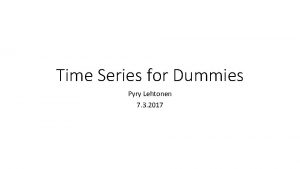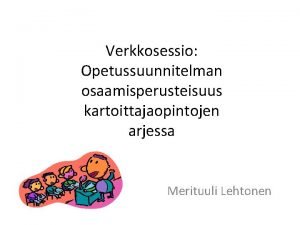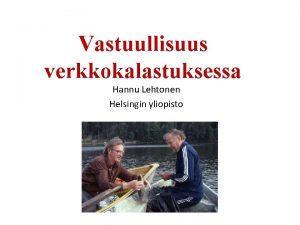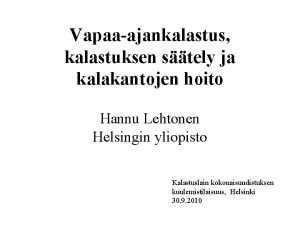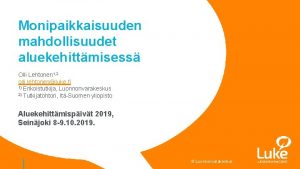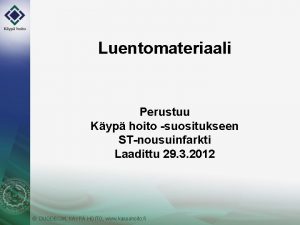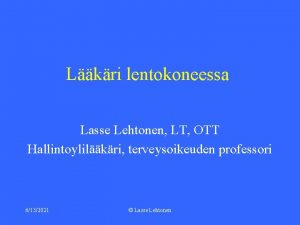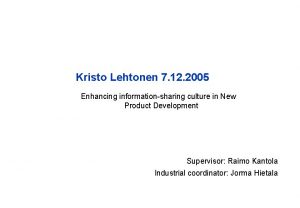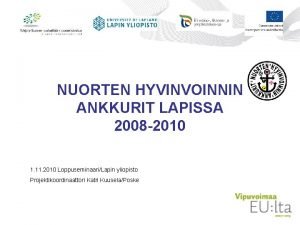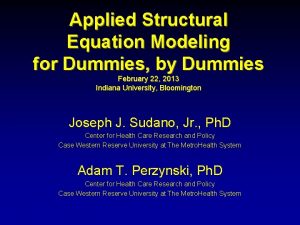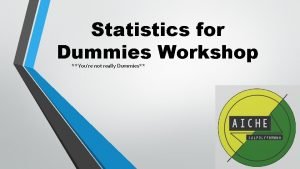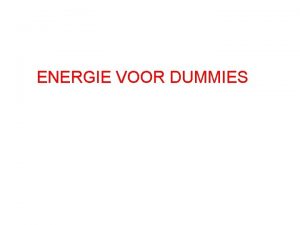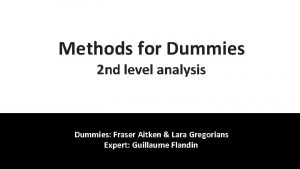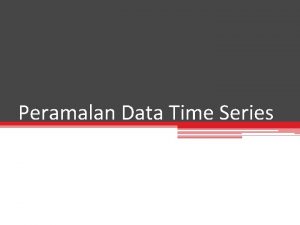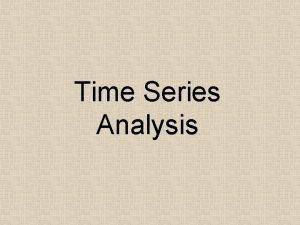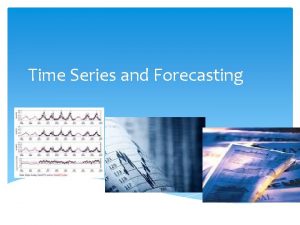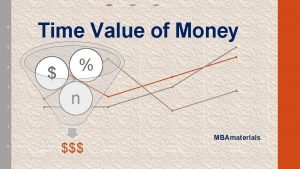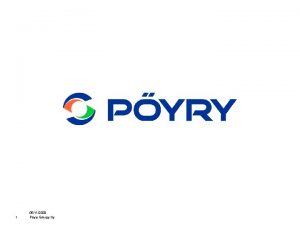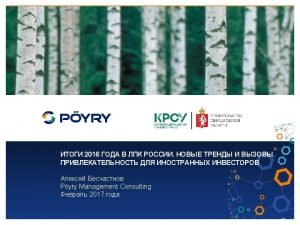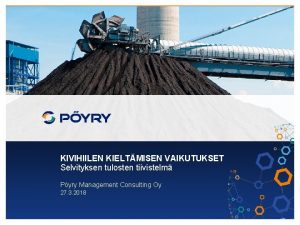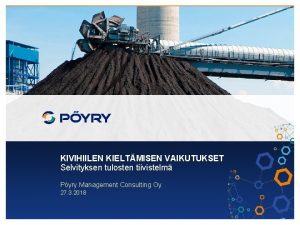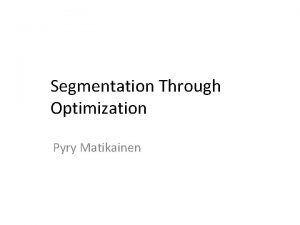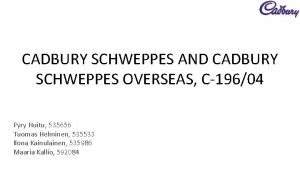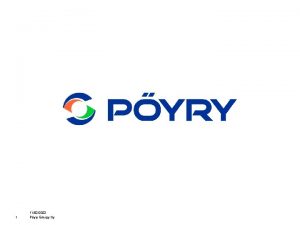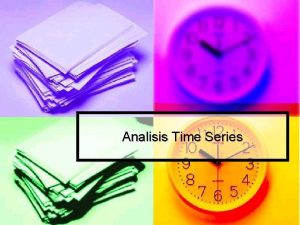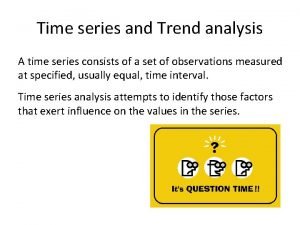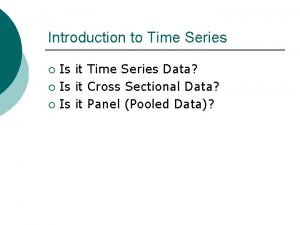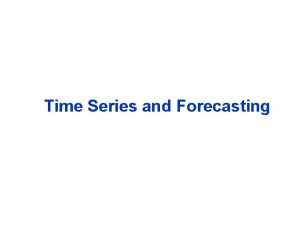Time Series for Dummies Pyry Lehtonen 7 3
































- Slides: 32

Time Series for Dummies Pyry Lehtonen 7. 3. 2017

(Weakly) Stationarity • Mean do not change over time • Variance do not change over time • Covariance do not change over time

White Noise •

Moving Average MA(q) Model •

Autoregressive AR(p) Model

Lag Polynomial AR(p) model MA(q) model • Solve roots of L • If all roots are greater than one in absolute value -> AR(p) is stationary • MA(q) is always stationary regardless of the roots

Impulse Response Function (IRF) • IRF is a measure of persistence • The more persistence the time series is, the longer will exogenous shock last • At the lag where IRF gets value of 0 -> shock do not have effect anymore

Cheat Sheet for Solving IRF Example is for AR(p) model but same goes for MA(q) model, only lag polynomial is different •

Representations in Other Models •

Autoregressive-Moving-Average ARMA(p, q) • ARMA combines AR and MA models • ARMA model is stationary if AR part is stationary (roots greater than one in absolute value) • MA part is always stationary • If ARMA is stationary, it has a MA(∞) representation:

Model Selection • Goal: Find simplest ARMA model that sufficiently captures dynamics of a time series 1. 2. 3. 4.

Model Selection Comparison of autocorrelation functions • AR(p) -> Autocorrelation last to infinity • MA(q) -> Autocorrelation lasts q periods, then go to 0 • ARMA(p, q) -> Autocorrelation lasts something between these two • Look at autocorrelation function and how long autocorrelation last • Predict which model is adequate

Model Selection Sequential testing and information criteria •

Model Selection Diagnostic checking •

Forecasting MA(q) • Forecasting can be done only up to q lags • If forecast horizont h > q, forecast yields only constant (if no constant -> 0) • Error terms of the future can not be forecasted & past values are known

Forecasting AR(p) • Forecasting can be done to infinity • Example: AR(1) with intercept Intercept has effect more than once

Random Walk •

Random Walk with Drift • Random walk exhibits trending behaviour • Constant term is included -> makes the drift as seen from equation • Random walk with a drift is like drunk student heading back to home: it has clear direction where to go but every step is random

I(0) and I(1) Processes • I(0) means stationary process • I(1) is a process that becomes I(0) after differencing once • Differencing means changing data points to changes • Helps to stabilize time series • Many economic data is not stationary, but differencing ones make them stationary (GDP, inflation, production etc. ) • I(1) processes is like random walk with drift, but I(0) is stationary • Effect of an error/shock to I(0) is temporary, but in I(1) infinite • Stationary data is easier to handle -> this is why differencing is done

Testing for an Unit Root • No growth Linear growth Exponential growth

Cointegration •

Testing for Cointegration •

Vector Autoregression VAR • Same as AR but multivariate case • Weakly stationary if roots of the following equation greater than unity in absolute value • Diagnostic checks etc. can be done the same way as in univariate AR case

Granger Causality •

Vector Error Correction Model VECM •

Vector Error Correction Model VECM • Adjustment vector Error correction term

Vector Error Correction Model VECM • VECM enables you to use non-stationary data (but cointegrated) for intepretation. This helps retain the relevant information in the data (which would otherwise get missed if data would be differenced)

Estimation and testing of cointegration •

• Hypothesis can be expressed as: • Suppose we have • H can be interpret as: Intercept -1 1 0 0 Intercept 0 1 -1 0 0 1

OLS with Time Series •


Test What we are testing? Null Alternative hypothesis Critical values Sequential testing last lag p of time series has influence to model No influence Ljung-Box test No Autocorrelation of residuals autocorrelation exists p-values Heteroskedasticity of Mc Leod Li test residuals Has influence Homoskedasticit Heteroskedastici y ty p-values Dickey-Fuller Unit roots Augmented Dickey-Fuller Cointegration of time series No cointegration exists Johansen Procedure Cointegration rank p-values Unit root exists No unit root H 0 rejected, if test result < critical value No cointegration Cointegration at Start from r=0 and stop when test at rank r statistic < critical value
 Time series for dummies
Time series for dummies Pyry lehtonen
Pyry lehtonen Gravity for dummies and dummies for gravity equations
Gravity for dummies and dummies for gravity equations Merituuli lehtonen
Merituuli lehtonen Hannu lehtonen professori
Hannu lehtonen professori Kaupallinen neuvonanto
Kaupallinen neuvonanto Hannu lehtonen kuollut
Hannu lehtonen kuollut Rainer lehtonen
Rainer lehtonen Olli lehtonen luke
Olli lehtonen luke Reperfuusiohoito
Reperfuusiohoito Jouko lehtonen
Jouko lehtonen Kuljetusliike kristo sakko
Kuljetusliike kristo sakko Kristo lehtonen
Kristo lehtonen Anurag lehtonen
Anurag lehtonen Start time end time and elapsed time
Start time end time and elapsed time Maclaurin series vs taylor series
Maclaurin series vs taylor series Balmer series lyman series
Balmer series lyman series Maclaurin series vs taylor series
Maclaurin series vs taylor series Taylor frederick
Taylor frederick Ibm p series server
Ibm p series server Feedback amplifiers
Feedback amplifiers Series aiding and series opposing
Series aiding and series opposing Arithmetic series formula
Arithmetic series formula Fspos
Fspos Typiska drag för en novell
Typiska drag för en novell Nationell inriktning för artificiell intelligens
Nationell inriktning för artificiell intelligens Vad står k.r.å.k.a.n för
Vad står k.r.å.k.a.n för Shingelfrisyren
Shingelfrisyren En lathund för arbete med kontinuitetshantering
En lathund för arbete med kontinuitetshantering Särskild löneskatt för pensionskostnader
Särskild löneskatt för pensionskostnader Tidbok
Tidbok A gastrica
A gastrica Densitet vatten
Densitet vatten
